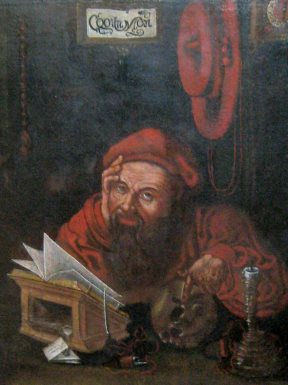"Eugnostos
[from the gnostic "Epistle of Eugnostos"] speaks of gnosis or
COOYN as the
revelational experience which cannot in itself be taught since it
transcends rational discourse..."
"COOYN
is an Egyptian word.... In
Egyptian funerary literature from the Pyramid Texts to the Greco-Roman Period, there was an idea of
ritual
knowledge...."
(p.139) [Emphasis added here and below]
"... the Nag Hammadi texts are written in the Egyptian language....
[S]ome of the texts are
undoubtedly translations for the Greek.... The Greek, the Jewish and the Christian
religious traditions are extremely common in the tests, and some texts imply
presume in their readership a rather detailed knowledge of the Old Testament.... There are very few
original motifs and ideas in these texts. An important exception, however, is the idea of
gnosis....
"Hans Jonas
excellently characterized the logic of the gnostic idea of religious knowledge by
stating that -- as the knowledge of God, of the order and development of the upper worlds, and of the
salvation of man -- it is a knowledge of the unknowable 'and therefore itself not a natural condition.'
This condition is attained in revelational experience, 'either through sacred and secret lore or
through inner
illumination,' and through rational argument.
"It is not rationally conveyed information that guides its receiver towards
salvation; the knowledge called gnosis implies in itself a modification of the human condition and is more directly
instrumental in the bringing about of salvation.
"Thus Gnostic 'knowledge' has an
eminently practical aspect. the ultimate 'object of gnosis is God: its even in the soul
transform the knower by making him a partaker in the divine existence (which means more than assimilating him to the divine essence). Thus... the 'knowledge' is not only
an instrument of salvation but itself the very form in which the goal of salvation, i.e.
ultimate perfection, is possessed.
"...knowledge
and attainment of the known by the soul are claimed to coincide-- the
claim of all true mysticism."
(pp. 137-138) ...
"Kurt Rudolph's monograph on Gnosticism
is a much broader empirical basis that
was available to Jonas, due... mainly to the publication of the Nag Hammadi library and the general increase in
Gnostic studies that it caused....
Rudolph sees Gnostic knowledge as distinct from intellectual or theoretical
knowledge, and as having a liberating and redeeming effect. It is given to the elect
through revelation and is thus esoteric in character....
"All Gnostic teachings are
in some form part of the redeeming knowledge which gathers together the
object of knowledge (the divine nature), the means of knowledge (the
redeeming gnosis) and the knower himself.... A man who possess 'gnosis'
if for that reason a redeemed man...."(p.138)
"Eugnostos [from the
gnostic "Epistle of Eugnostos"] speaks of gnosis or
COOYN as the
revelational experience which cannot in itself be taught since it
transcends rational discourse, but of which the teachings of his epistle are nevertheless the arch or, to
emphasize the practical, pedagogical aspect, the preparation.
"COOYN
is an Egyptian word.... In
Egyptian funerary literature from the Pyramid Texts to the Greco-Roman Period, there was an idea of
ritual
knowledge....
"One of the points made by Jonas is that in
gnosis, the relation of knowing is mutual; to know is
also to be known. A very similar idea is widespread in ancient Egyptian funerary literature; let me just quote a Pyramid Text from c.2200 BC:
"Whoever really knows it, this utterance of RE, and recites them, these spells of Harakhti, he shall be the
familiar (known by) Re [or
Ra--Egyptian sun god], he shall be the companion of Harakhti
[or Horus]."
"This may conveniently be compared with one of the texts from the Gospel of Truth which
Rudolph quotes as illustration of his account:
"If anyone has gnosis, he is a being who comes from above...."
[as in Mormonism?]
"...there are hundreds of
examples in Egyptian funerary literature of a kind of ritual knowledge-- of
spells, gods, mythological events... etc.--which serves to render the
deceased person co-primeval with the gods and mythological features of which
he claim to have knowledge..."(p.139)
"Recited daily by a living man [this religious knowledge]
will keep him hale as long as he lives. ...such a recitation had soteriological aims:
regeneration after death and protection in life..... This use of the Book fort
the Dead 'on earth' is also called knowledge.
"Chapter 70 ends with the words:
"As for him who knows this book on earth, he shall come out
into the day, he shall walk on earth among the living, and his name shall not perish forever."
... The Book
of the Dead is no devotional tract, and its idea of religious knowledge is still that of a ritual knowledge, efficacious in a ritual sense.... There are... obvious
differences between ritual and revelation. Above all, in the sense which is
relevant here, revelation presupposes a dualism alien to classical Egyptian religion, but
prominent in the
Hellenist and Roman world.
"During the Late Period and the Greco-Roman Period,
however, Egyptian religion develops both he "mental" and an apocalyptic
dimension that bridges, at least to certain extent, the gap between ritual and revelation. This
development can be traced above all in the Demotic and Greek magical papyri, which are
still very faithful to the classical Egyptian way of constructing magical
formula, but open to new applications of the magic art.
"Whereas classical Egyptian
magical texts were designed for practical purposes such as healing oft he
handling of dangerous situation, their late descendants are definitely more
luxurious; Love magic and formulae designed to give enemies nightmares and
other disturbances...."(p.140)
We hope
to finish this page soon.
See
The Secret
- Christianity or New Age
Clothed with His Truth
(First lesson in a Bible study on the Armor)
Endnotes:
1.http://books.google.com/books?id=mEa0LKvxPGQC&pg=PA137&lpg=PA137&dq=cooyn+egypt&source=web&ots=7ZwAlPq7Hh&sig=9COr55HeU1uxav0cgXheZNx1ZMM

